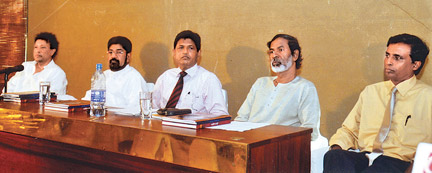Media freedom upheld, no restrictions – Media Ministry Secretary
By L.S. Ananda WEDAARACHCHI
There is unprecedented media freedom in Sri Lanka today. The Ministry
of Mass Media and Information provides all facilities including training
to improve the knowledge and skills of media personnel in the country
said Mass Media and Information Ministry Secretary W.B. Ganegala.
 |
|
Media Ministry
Secretary
W.B. Ganegala |
The Sunday Observer interviewed the Ministry Secretary recently.
Excerpts of the interview:
Q: Can you outline the main objectives of the Ministry?
A: The Media Ministry implements various programs and projects
to educate and facilitate the electronic and print media personnel to
practice their profession effectively. Our main objective is to herald a
informative society.
Q: After the defeat of terrorism a major development drive has
been launched to make the country the Wonder of Asia. Motivating the
people to achieve this goal is important. What are the projects launched
to realize this ideal.
A: Although terrorism has been defeated LTTE activists abroad
remain unabated. Even during the humanitarian operation several
development projects were launched and such project came to fruition
after the defeat of the LTTE in May 2009. Sri Lanka is the fastest
developing country in Asia today.
Media personnel have a vital role to play to ensure the success of
this massive development drive.
No country achieved their developmental goals without the active
participation and support of the media and media personnel.
We work not only with the government media institutions but also with
the huge network of private sector media organisations.
Over 35 FM channels, 15 Television channels and 160 newspapers have
been registered in Sri Lanka at present.
Whatever the private agendas they have, private sector media
organisations should help implement the national agenda in disseminating
information praising each and every government action is not the
responsibility of the media. Rather the media should level constructive
criticism to put back the authorities on the track.
 |
|
Mass Media and Information Minister
Keheliya Rambukwalle at the training program “Asidishi” for
media personnel. Information DG Prof. Ariyaratna Athugala,
Ministry Secretary W.B. Ganegala, Divaina Editor in Chief
Gamini Sumanasekera and Director Information Wasanthapriya
Ramanayaka are also in the picture. |
Q: Investigative journalism had revealed wrong doings on the
part of the authorities world over such as America’s Watergate incident.
Such actions in the interest of transparency and decent public life for
an efficient administration. Your comments?
A: It is vital to the media to reveal what has been called the
“exact situations” in good faith.
The present government was voted to office with a landslide victory.
All sections of the society including media must support the government
to reach its developmental goals Mahinda Chintana is not a election
manifesto. It is the developmental blueprint of the present government
endorsed thrice by the people.
Media too should act in keeping with the Mahinda Chintana
Q: The majority of the TV channels, radio stations and
newspapers work to suit their own agendas. One newspaper organisation,
Two TV channels and two radio stations have direct dealings with the
government. Is this not a too complicated atmosphere to produce quality
work.
A: The Mass Media and Information Ministry maintains cordial
relations with the media network.
Our projects and programs benefit all media personnel whether they
are public or private sector organisations. What is most important is to
improve the quality of journalists to suit the present society.
Today we live in the global village. What happens this morning in
Colombo will be discussed in a few minutes perhaps at an international
symposium held abroad. We only need knowledgeable and competent media
men in the existing free media environment.
Q: Could you explain the present media environment in the
country.
A: There is media freedom in the country at present. There are
no restrictions placed on media organisations or media personnel.
Severe criticisms levelled against the government can be seen in the
privately managed newspapers.
The news inflow and outflow and information channels are free to
operate.
A few months ago the government wanted the websites to be registered
when the aggrieved parties sought a legal remedy the courts upheld the
government decision.
 |
|
A scene from Prof. Sunil
Ariyaratna’s Kusa Paba filmed at Ranmihitanne. |
Constructive criticism and subscribing to government’s forward march
is all that we are interested in.
Q: What are the programs launched to improve the quality of
journalism in the country?
A: The budget allocates annually from 2006 a fair amount of
funds to develop media industry. Various training programs workshops,
seminars have been conducted in Colombo and in outstations for
electronic and printed media personnel.
Financial assistance is also provided to follow university degree
programs. The media Ministry has a loan scheme launched for journalists
to purchase media equipment such as laptops, computers, cameras and fax
machines on a very low interest rate.
Q: Mass media is one of the popular subjects in the university
curriculum. Is there a program launched by you to improve the skills and
knowledge of working journalists or prospective journalists.
A: Over 8,000 media personnel work for media organisations.
The Information Department and the Press Council together with the
veterans of the media field and university dons have organised various
seminars and workshops for them.
A state-of-the-art media centre was opened in the Ministry premises
recently. Another educational institute and a centre for journalists in
Colombo is in the pipeline.
Q: President Mahinda Rajapaksa in his 2012 Budget speech
provided an interest-free loan scheme of Rs.1.2 million for Senior
journalists to purchase vehicles and applications have been called for
by the media Ministry from journalists. What is the progress of the
scheme?
A: Applications are being scrutinized at present.
Q: It is widely believed that media institutions work
according to the agenda of the media organisations’ owners.
Could independent media personnel work according to their conscience
or in the national interest under such an atmosphere?
A: Owners of Media institutions invest capital to achieve
their goals. There are rare instances where media men with a sense of
proportion who stand for the interest of the country. There is a
progressive media culture in Sri Lanka which is conducive to the
development of the country.
The international opinion is that Sri Lanka is in the right track in
the media trade.
There are some indices such as Gross National Income rate of growth,
and unemployment which is used to measure the progress of any country.
China has registered over 10 percent growth while Sri Lanka achieved 8.5
percent growth last quarter compared to other countries to other
regions.
In 2005 Sri Lanka’s per capita income was only US $ 800, whereas now
it is over US $ 2400. President Mahinda Rajapaksa believes it might
reach US $ 4500 within a few years. Sri Lanka is not designated as a
poor nation as it is heading towards a prosperous society.
Since President Rajapaksa has transformed the terror-hit country to
what it is today, his voice reflects the voice of the nation. It is time
for the media together with others to march forward to achieve his
vision.
Q: Tourists arrivals have increased sharply during the last
few years. The attitude of the developed world to invest in Sri Lanka
has positively changed. Your comments?
A: When Sri Lanka experience zero development in the GDP in
2001 no country came forward to invest in Sri Lanka. The situation today
is entirely different. Foreign aid on very attractive terms are offered
to the country. Massive infrastructure development projects such as
ports, roads and airports, Uma Oya and Kotmale schemes, the Sapugaskanda
Oil Refinery Development, Urban and village development and water supply
schemes are some of projects that have been largely facilitated with
foreign funds. It is the duty of the media to convey this message to the
country.
Q: What is the present progress of the Ranmihitanne Tele
Village.
A: There was the practice of screening Indian Mega teledrama
series and tele commercials in 2006 which affected the local tele drama
industry.
The local artistes made representation to the President against this
and the government took steps such as imposing heavy taxes on mega
Indian tele dramas to discourage this practice. Such taxes were
channelled into a special fund for the benefit of tele field and tele
artistes. Ranmihitanne tele village was financed by that fund.
Over 12 local tele dramas have been produced at Ranmihitanne. Prof.
Sunil Ariyaratna’s Kusa Paba was produced at Ranmihitanne TV Village.
The second phase of Ranmihitanne will be launched next month. A film
studio worth over Rs.300 million will be built in the second phase of
Ranmihitanne project. |

